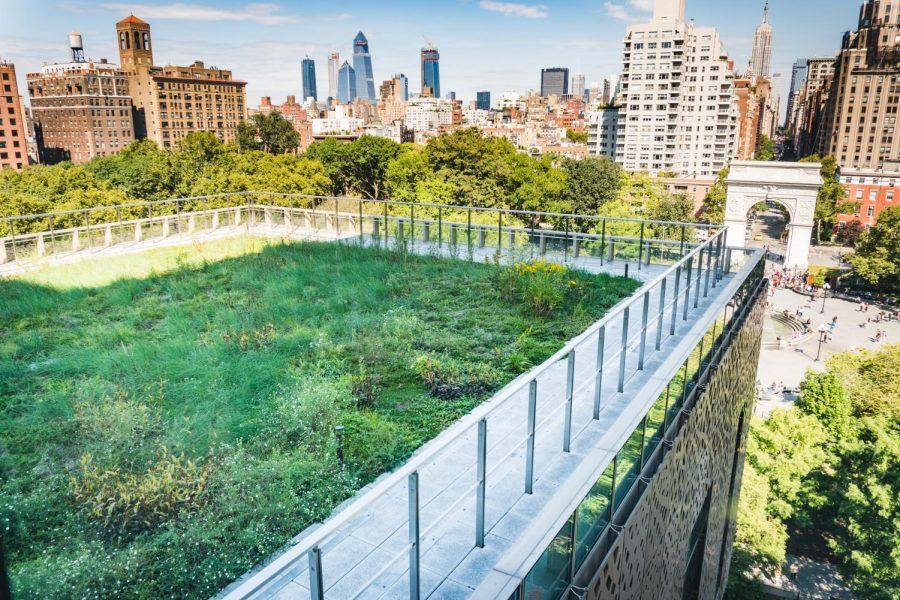NYU Inches Toward Carbon Neutrality
238 Thompson Rooftop Garden, one of NYU’s landscaping projects, sits on top of the Global Center for Academic and Spiritual Life. (Staff photo by Tony Wu)
October 1, 2018
Immersed in the concrete jungle of New York City, few universities offer less green space than NYU. Undeterred, campus leaders are committed to defying the odds and proving a point: an urban setting need not prevent NYU from becoming one of the most sustainable campuses in the nation.
Last week, NYU announced an array of immediate initiatives for the 2018-19 academic year, including the implementation of solar panels on the Elmer Holmes Bobst Library, the reduction of disposable plastics in dining halls and capital commitments to making NYU buildings more energy efficient.
“What we’ve done by enhancing the resources of the Office of Sustainability is not only to give greater voice and added emphasis to environmental advocacy, but we’re introducing the right kind of bold thinking into our strategic planning efforts at the right time,” NYU President Andy Hamilton wrote in a statement to WSN.
NYU has steadily increased its focus on sustainability practices since 1982 when the first environmental student group, Earth Matters, was formed. Since then, NYU has developed a recycling program, a sustainability task force, reduced greenhouse gas emission by more than 30 percent in 2007, created a natural gas-fired Cogeneration plant and recently pledged to reduce its greenhouse gasses by 50 percent by 2025. NYU aims to achieve complete carbon neutrality by 2040.
Ecoreps coordinator and Gallatin senior Dylan Garcia believes carbon neutrality by 2040 is an achievable goal.
“New York City’s plan is an 80 percent reduction in greenhouse gas emissions by 2050, so comparatively, NYU’s is more ambitious,” Garcia said. “I think neutral by 2040 is a very reasonable goal, and personally, I think New York City as a whole could do better than [that], given what other cities are doing.”
This shift in values to a greener urban campus stems from the voices of NYU students.
In April 2018, the university launched an online forum for students to share their input as to how to make NYU’s campus greener. Garcia emphasized that the ideas gathered from this medium have been integral to new goals.
“As an employee of the Office of Sustainability, I can say that the Sustainability at NYU forum that the school put out last semester was instrumental in creating this plan,” Garcia said. “They wanted this to be a democratic process and they carried that out in the best way possible.”
According the Vice President for Sustainability Cecil Scheib, switching to a sustainable energy source, such as solar or wind, is the main obstacle to achieving carbon neutrality. The university aims to do this by putting photovoltaic panels on the roof of Bobst that will generate 10 percent of the building’s daily electricity. The panels are meant to serve as a pilot for future initiatives in the hopes of expanding the program on other NYU buildings. However, NYU’s urban campus faces unique challenges that make total solar reliance nearly impossible.
“The challenges in New York are that our buildings are tall and skinny,” Scheib said. “It’s not a Walmart with just acres and acres of roof area. Our roofs have a lot of other things already on them: chimneys, vents, mechanical equipment, the top of the elevator and often in New York City buildings shade other buildings.”
NYU has committed around $3.5 million annually to ensure all new buildings will achieve Leadership in Energy and Environmental Design certification; as of 2018, 10 campus buildings are certified, while several others have applied for certification. Renovations are also helping NYU reach its environmental goals; the 2014 renovation of Brittany Residence Hall cut carbon usage by 66 percent, allowed the building to receive LEED certification and has since saved NYU $240,000 each year.
Scheib lauds the LEED certification system because, on top of carbon and energy usage, aspects such as air quality, water and transportation are considered.
“Buildings are more than 90 percent of our carbon footprint,” Scheib said. “If we want to attack our own health and solve our carbon issue and fight climate change, it all starts in buildings.”
In addition to renovating campus buildings, there are specific members in the working group helping NYU achieve carbon neutrality through other means. Supervisor of Sustainable Landscaping George Reis is one of the members heading agricultural and recycling initiatives around campus to help NYU reach a zero waste output.
“There are different things that we can do to reduce waste in our gardens,” Reis said. “Compost is the most obvious one, but there are others — the way you select plants, the size of plants that you buy.”
Gardens and agriculture at NYU are rarely acknowledged, but have a measurable impact on New York City’s carbon footprint. Reis hopes that monitoring the trees’ impact will encourage more green spaces on campus.
“Trees sequester carbon and we have about 600 trees here at NYU which no one realizes because they’re so scattered around,” Reis said. “We did an inventory on them this summer to try and determine how much carbon is sequestered at NYU. Hopefully, it motivates more tree maintenance and more trees at NYU.”
Reactions to the initiative from campus leaders seems largely positive. But one student activist group, NYU Divest, feels the university’s efforts don’t go far enough.
“Carbon neutrality is important, but it is not sufficient for climate mitigation that is truly effective, comprehensive and just,” NYU Divest wrote in a statement to WSN. “NYU must commit to achieving 100 percent renewable power, heating, cooling, and transportation by 2040.”
NYU’s sustainability goals are backed by the top levels of its administration. However, Scheib emphasizes, its goals cannot be achieved without the participation of all members of the NYU community.
“NYU is a huge place and the Office of Sustainability is small,” Scheib said. “The Office of Sustainability can’t do it for everyone. We have expertise and we can help and we can influence, but everyone needs to be involved.”
Email Alex Domb and Kristina Hayhurst at [email protected]. A version of this article appeared in the Monday, Oct. 1 print edition.





























































































































































